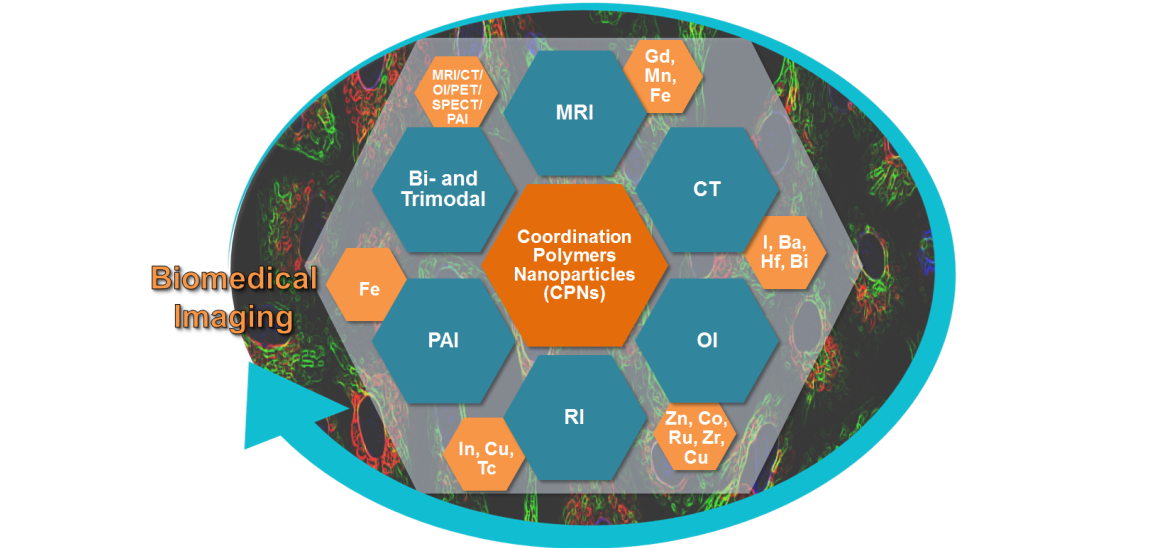Thursday, 29 April 2021
Advancements and challenges of using coordination polymer nanoparticles in bioimaging
A review published in Coordination Chemistry Reviews reports on the use of nanoparticles and, specifically, coordination polymer nanoparticles in the field of bioimaging for diagnostics. It describes the progress done in several techniques, such as magnetic resonance imaging or photoacoustic imaging.

Early diagnosis of diseases is crucial for promptly applying the appropriate treatment, which results in a higher survival rate of patients. Currently, bioimaging techniques –including, among others, magnetic resonance imaging (MRI), computer tomography (CT), optical imaging (OI), radioimaging (RI), and photoacoustic imaging (PAI)– are key to identifying an ample spectrum of diseases. Specific probes or agents, though, are required for each of them. These molecular imaging agents are needed to maximize the image contrast, but they also must be stable and safe for application in the in vivo environment, as well as cheap to produce.
A paper recently published in Coordination Chemistry Reviews summarizes current investigations on the use of nanoparticles as contrast agents for bioimaging for diagnostics, focusing in particular on coordination polymer nanoparticles. Led by Dr Daniel Ruiz Molina, head of the Nanostructured Functional Materials group at the ICN2, this review study has Dr Salvio Suárez-García as first author and was carried out in collaboration with members of the Department of Chemistry of the Autonomous University of Barcelona (UAB).
Nanoparticles can offer significant advantages as contrast agents. They can be easily functionalised for better targeting and biodistribution and, in the case of tumours, they show stronger preferential gathering due to a so-called Enhanced Permeability and Retention (EPR) effect. Several kinds of nanoparticles have been investigated for these uses. Recently, semiconducting polymer nanoparticles have emerged as one of the most skillful organic agents for bioimaging. Their versatile light-responsive properties allow them to meet the specific requirements for different bioimaging applications. But they come with throwbacks as well, such as toxicity issues, failure targeting and harmful accumulation in organs.
As explained in the review, coordination polymer nanoparticles (CPNs) have raised considerable interest as possible agents for bioimaging, but also as drug delivery vectors. They can encapsulate active molecules, have excellent colloidal stabilities and show multifunctional properties. These remarkable characteristics make them promising candidates for theranostics, i.e. the combination of diagnostic and therapeutic functionalities in a single procedure. The paper thoroughly describes the use of CPNs in several techniques of bioimaging (MRI, CT, OI, RI, PAI and combinations of two or three of them), analysing some of their key properties, such as sensitivity and scan time, as well as the metal ions that can be used for the synthesis of the agents.
CPNs exhibit great prospects as contrast agents and bioimaging probes, thanks to the inherent advantageous properties demonstrated by nanostructured materials. Their application in this field opens the way to improved tools for earlier diagnostics and for better and personalised medicine.
Reference article:
Salvio Suárez-García, Rubén Solórzano, Fernando Novio, Ramon Alibés, Félix Busqué, Daniel Ruiz-Molina, Coordination polymers nanoparticles for bioimaging, Coordination Chemistry Reviews, 432, 213716, DOI: 10.1016/j.ccr.2020.213716

